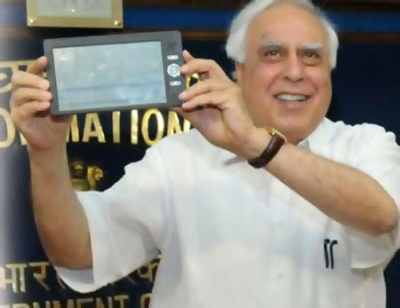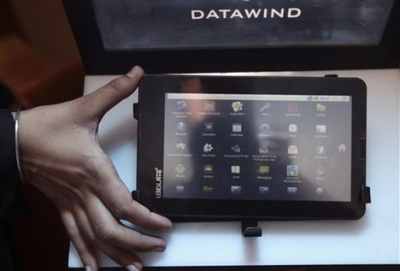Photographs: Reuters. BS Bureau
Human Resource Development Minister M M Pallam Raju has sought a review of the Aakash low-cost computing project, unless Datawind, the supplier of these computing devices, meets its commitment to provide 100,000 Aakash 2 tablets by March 31.
Two separate committees have been asked to evaluate why and how the project has got delayed.
Not surprisingly, the delays and controversies plaguing the Aakash project have a ring of familiarity for anyone acquainted with defence research and procurement.
...
Will Aakash succeed even as it fails?
Image: Union Minister of Communications & IT, Kapil Sibal with Aakash.Photographs: Reuters.
Aakash has run into much the same issues that have held up the Main Battle Tank and the Light Combat Aircraft.
Like many defence projects, Aakash suffered from poorly conceived specifications, unrealistically grandiose plans, massive time and cost overruns, pushes and pulls within ministries, quality issues and disputes with the vendor.
The difference is that it is consumer-facing and hence, the problems are more easily ventilated.
...
Will Aakash succeed even as it fails?
Photographs: Reuters.
Aakash is now two years beyond its initial delivery date. The first units were to be delivered in February 2011.
When the initial units (Aakash 1) were delivered in November 2011, the government decided upon an upgrade. R&D was shifted to IIT Bombay in February 2012 and Aakash 2 was revealed in November 2012.
The government announced that it was looking at initial orders of around five million units and eventually, with upgrades to versions 3 and 4, hoping to launch around 220 million subsidised tablets.
...
Will Aakash succeed even as it fails?
Photographs: Reuters.
Those are huge numbers – the global market for tablets is 70 million units.
As of now, Datawind has delivered about 20,000 units and claims to be manufacturing between 2,500 and 3,000 units a day. Understandably, there is scepticism about the targets being met.
But, even if the project never comes anywhere near fruition, that is not to say that there have been no positive takeaways at all.
One good outcome has been the realisation by hardware manufacturers that India provides a potentially vast low-end market.
...
Will Aakash succeed even as it fails?
Photographs: Reuters.
Spurred by Aakash, many devices in the $50 (about Rs 2,700) range with comparable or better specifications have already been released.
There are likely to be more in the pipeline. Indian telecom service providers have also started looking at bundled device-plus-data plans to suit pockets at that price-point. (Aakash 2 is supposed to be bought by the government at $50 and re-supplied to students at a subsidised $35).
The other positive thing is that Aakash focused attention on the need for a digital educational ecosystem.
...
Will Aakash succeed even as it fails?
Image: Aakash tablet.Photographs: Courtesy, Datawind.
The creation of digital educational content that can be consumed on a low-end tablet and the availability of computer programs that can run on such basic resources has received a boost.
Apart from the National Council of Educational Research and Training and other government-controlled educational bodies, the content and programming will also be contributed by private enterprise.
...
Will Aakash succeed even as it fails?
Photographs: Courtesy, Datawind.
The initial premise remains valid. There is a digital divide that cripples Indian students from low-income backgrounds.
If that divide is bridged by affordable solutions, the future productivity of the workforce will be enhanced.
Aakash may not be that solution, but it may well serve the purpose of inspiring private enterprise to bridge the gap.









article